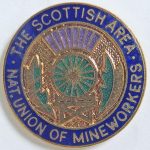National Union of Scottish Mineworkers facts for kids
 |
|
| Founded | 1894 |
|---|---|
| Dissolved | 2018 |
| Headquarters | Culross, Fife |
| Location | |
|
Members
|
67,200 (1907) 35 (2014) |
|
Key people
|
Nicky Wilson (Secretary and President) |
| Publication | Scottish Miner |
|
Parent organization
|
MFGB (1894–1944) National Union of Mineworkers (1945–2018) |
The National Union of Scottish Mineworkers (NUSW) was a trade union in Scotland. It was started in 1894 to help miners. Miners are people who dig for coal and other materials deep underground. A trade union is like a team that helps workers get fair pay, good working conditions, and safety. The NUSW worked to make life better for Scottish miners.
The union first joined a larger group called the Miners' Federation of Great Britain. In 1914, its name changed to the National Union of Scottish Mineworkers. Later, it became part of the National Union of Mineworkers (NUM) in Scotland.
During the 1920s and 1930s, the union was strongly influenced by leaders who believed in socialism and communism. These ideas focus on making society fairer for everyone. The union members fought hard for better wages and living conditions. During World War II, they greatly helped the government. They did this by increasing the amount of coal they dug from the mines. In 1944, the National Union of Mineworkers was formed. The NUSW then became its "Scottish Area." This meant it had less power to make its own decisions. In the late 1900s, coal mining in Scotland and Great Britain greatly decreased. This caused thousands of miners to lose their jobs.
Early Attempts to Form a Union
Before the NUSW, Scottish miners tried many times to form a strong union. These early attempts often faced big challenges. For example, in 1855, a union called the Scottish Coal and Iron Miners' Association started a strike. A strike is when workers stop working to demand better conditions. This strike was against lower wages, but the miners lost. The union soon broke apart.
Another union, the Scottish Miners' Amalgamated Society, formed in 1859. It did not achieve much because each local union acted on its own. It eventually dissolved in 1863.
In 1872, the Scottish Miners' Association was created. It worked closely with a similar union in England and Wales. This union had quick success. It almost tripled miners' pay and reduced how much coal mines produced. However, a major strike in 1874 used up all the union's money. It went bankrupt in 1882 after another strike.
In 1886, a famous politician named Keir Hardie started the Scottish Miners' National Federation. He used its newspaper, The Miner, to campaign for important changes. He wanted the government to own the coal mines. He also pushed for a minimum wage and a five-day work week. Even though this union also dissolved, some of its local groups continued to exist.
The Union's History
The National Union of Scottish Mineworkers began in 1894. It was first known as the Scottish Miners Federation (SMF). It brought together seven county unions at first. Other unions joined soon after. When it started, it had about 35,900 members.
Some of the unions that joined early on included:
- The Ayrshire Miners' Federal Union
- The Fife and Kinross Miners' Association
- The Lanarkshire Miners' Federation
- The Mid and East Lothian Miners' Association
- The Stirlingshire, Forth and Clyde Valley Miners' Association
The new union immediately organized a strike. They wanted better pay and working conditions. The SMF also joined the Miners' Federation of Great Britain. This led to some disagreements. The SMF president, Robert Smillie, agreed to lower wages, like the English unions. But the union's secretary, Chisholm Robertson, and other leaders disagreed.
Even though this early strike was lost, the union kept going. Its membership dropped for a while. But by the end of the 1890s, more members joined. As coal prices went up, the union was able to win more of its demands. The SMF became known for strongly supporting socialism.
By 1914, the union had grown to about 82,000 members. About half of them were in Lanarkshire. The union changed its structure. Its smaller local groups had less power. It was then renamed the "National Union of Scottish Mineworkers." In 1929, some left-wing members left. They formed a rival group called the United Mineworkers of Scotland. They later rejoined the NUSW in 1936.
In 1944, the Miners' Federation of Great Britain became the National Union of Mineworkers (NUM). The NUSW then became the Scottish Area of the NUM. This meant it had less freedom to make its own decisions than before.
By 2014, the union had only 35 members left. The mining industry in Scotland had almost completely disappeared. The National Union of Scottish Mineworkers officially closed down in 2018.

